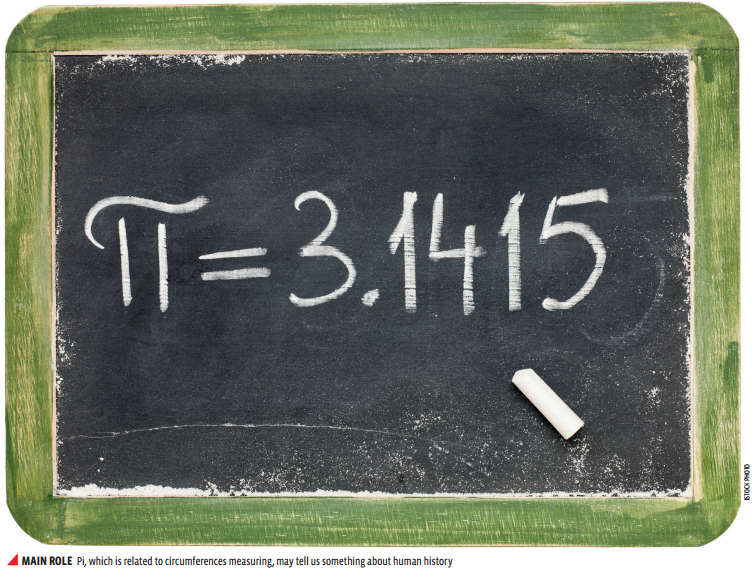Inglês: Interpretação – A history of Pi
A book tells about the mathematical constant π as a route of the human history

The history of Pi, says the author, though a small part of the history of mathematics, is nevertheless a mirror of the history of man. Petr Beckmann holds up this mirror, giving the background of the times when Pi made progress – and also when it did not, because science was being stifled by militarism or religious fanaticism. The mathematical level of this book is flexible, and there is plenty for readers of all ages and interests.
About the author
Petr Beckmann was born in Prague, Czechoslovakia, in 1924. Until 1963, he worked as a research scientist for the Czechoslovak Academy of Sciences, when he was invited as a Visiting Professor to the University of Colorado, where he decided to stay permanently as professor of electrical engineering. Dr. Beckmann has authored 11 books and more than 50 scientific papers, mostly on probability theory and electromagnetic wave propagation. History is one of his side interests; another is linguistics (he is fluent in five languages and he has worked out a new generative grammar which enables a computer to construct trillions of grammatical sentences from a dictionary of less than 100 unprocessed words). He also publishes a monthly pro-science, pro-technology, pro-free enterprise newsletter Access to Energy, in which he promotes the viewpoint that clean energy can be made plentiful, but that access to it is blocked by government interference and environmental paranoia.>
BECKMANN, Petr. A History of Pi. New York: Barnes & Noble Books, 1983. (Vestibular ITA 2014, adaptado)
EXERCÍCIOS – ITA 2014 (adaptado)
1. O livro A History of Pi:
a) descreve grande parte da história da matemática e da humanidade.
b) é direcionado apenas para iniciantes em matemática.
c) conta a história de Petr Beckmann em tempos de repressão ao conhecimento.
d) associa conceitos matemáticos a fatos da vida cotidiana.
e) é acessível a um público diversificado.
2. No contexto deste texto, o item lexical “stifled”, no trecho “science was being stifled by militarism or religious fanaticism” pode ser traduzido por:
a) sufocada.
b) desmascarada.
c) organizada.
d) promulgada.
e) institucionalizada.
3. Indique o item lexical que pode substituir o sublinhado no trecho “… mostly on probability theory and electromagnetic wave propagation”, sem prejudicar o seu sentido.
a) absolutely.
b) chiefly.
c) inherently.
d) randomly.
e) utterly.
4. A opção que contém a reescrita correta de “science was being stifled by militarism or religious fanaticism” em “Militarism or religious fanaticism…” é:
a) were stifling science.
b) had been stifling science.
c) were being stifling science.
d) has stifling science.
e) have been stifling science.
5. Indique a alternativa que contém a referência correta para o termo em negrito.
a) “giving the background of the times when Pi made progress…” → background.
b) “Petr Beckmann holds up this mirror, giving the background of the times when Pi made progress – and also when it did not …” → mirror.
c) “Until 1963, he worked as a research scientist for the Czechoslovak Academy of Sciences, when he was invited …” → research scientist.
d) “he is fluent in five languages and he has worked out a new generative grammar which enables a computer to construct …” → five languages.
e) “He also publishes a monthly pro-science, pro-technology, pro-free enterprise newsletter Access to Energy, in which he promotes the viewpoint …” → newsletter Access to Energy.
RESPOSTAS
1. Analisando cada alternativa:
a) O trecho “though a small part of the history of mathematics” significa que o Pi representa apenas pequena parte da história da matemática. Incorreta.
b) “The mathematical level of this book is fexible, and there is plenty for readers of all ages and interests” (o nível da matemática do livro é fexível e há muito para leitores de todas as idades e interesses). Incorreta.
c) Petr Beckmann é o autor, não personagem do livro. Incorreta.
d) Segundo o texto, o conceito da constante matemática π (pi) é associado a épocas da história, não a fatos do cotidiano. Incorreta.
e) Como já analisamos na alternativa b, o livro é acessível a um público diversificado. Correta.
Resposta: e
2. O verbo “to stife” significa sufocar, interromper, frear. De todas as expressões apresentadas, a única que se encaixa no contexto é “sufocada”. Traduzido, o trecho em questão fica: “a ciência foi sendo sufocada pelo militarismo ou fanatismo religioso”.
Resposta: a
3. O termo “mostly” pode signifcar “em sua maior parte”, “ maioria” ou “principalmente”. De todas as alternativas, apenas a b apresenta um sentido correto. As demais palavras significam:
• absolutely = absolutamente;
• inherently = inerentemente, intrinsecamente;
• randomly = aleatoriamente;
• utterly = completamente, totalmente.
Resposta: b
4. A oração “… science was being stifed by militarism or religious fanaticism.” (… a ciência foi sendo sufocada pelo militarismo ou fanatismo religioso) está na voz passiva. A questão pede que você a passe para a voz ativa, com “militarism or religious fanaticism” como sujeito. O fundamental é prestar atenção no tempo do verbo. A voz ativa correta da oração é “Militarism or religious fanaticism were stifing science” (Militarismo ou fanatismo religioso estavam sufocando a ciência).
Resposta: a
5. Analisando cada uma das alternativas:
a) O termo “when” (quando) é um advérbio de tempo. Portanto, refere-se a “times”. Incorreta.
b) O pronome “it” refere-se a “pi”, e não a “mirror”. Incorreta.
c) Novamente, o advérbio “when” diz respeito ao tempo. No texto, o ano de 1963. Incorreta.
d) O pronome relativo “which” (o qual, que) não se refere a “five languages” (cinco línguas, ou linguagens), mas a “new generative grammar” (nova gramática generativa). Incorreta.
e) Sim, a expressão “in which” (no qual, na qual, nos quais, nas quais) refere-se a newsletter publicada por Beckmann. Correta.
Resposta: e









